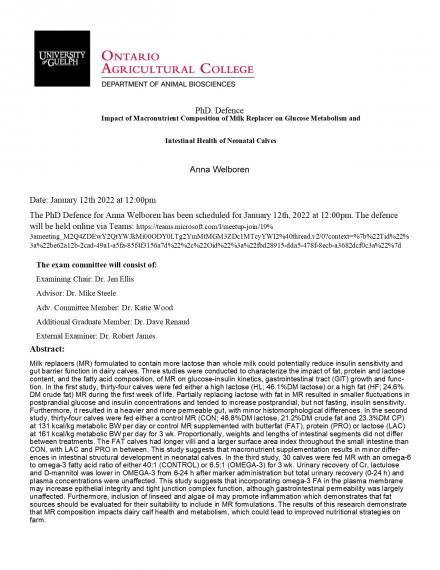Anna Welboren's PhD Defence
Date and Time
Location
Teams: https://teams.microsoft.com/l/meetup-join/19%3ameeting_M2Q4ZDEwY2QtYWJkMi00ODY0LTg2YmMtMGM3ZDc1MTcyYWI2%40thread.v2/0?context=%7b%22Tid%22%3a%22be62a12b-2cad-49a1-a5fa-85f4f3156a7d%22%2c%22Oid%22%3a%22fbd28915-dda5-478f-8ecb-a3682dcf0c3a%22%7d

Details
Milk replacers (MR) formulated to contain more lactose than whole milk could potentially reduce insulin sensitivity and gut barrier function in dairy calves. Three studies were conducted to characterize the impact of fat, protein and lactose content, and the fatty acid composition, of MR on glucose-insulin kinetics, gastrointestinal tract (GIT) growth and func-tion. In the first study, thirty-four calves were fed either a high lactose (HL; 46.1%DM lactose) or a high fat (HF; 24.6%DM crude fat) MR during the first week of life. Partially replacing lactose with fat in MR resulted in smaller fluctuations in postprandial glucose and insulin concentrations and tended to increase postprandial, but not fasting, insulin sensitivity. Furthermore, it resulted in a heavier and more permeable gut, with minor histomorphological differences. In the second study, thirty-four calves were fed either a control MR (CON; 48.8%DM lactose, 21.2%DM crude fat and 23.3%DM CP) at 131 kcal/kg metabolic BW per day or control MR supplemented with butterfat (FAT), protein (PRO) or lactose (LAC) at 161 kcal/kg metabolic BW per day for 3 wk. Proportionally, weights and lengths of intestinal segments did not differ between treatments. The FAT calves had longer villi and a larger surface area index throughout the small intestine than CON, with LAC and PRO in between. This study suggests that macronutrient supplementation results in minor differ-ences in intestinal structural development in neonatal calves. In the third study, 30 calves were fed MR with an omega-6 to omega-3 fatty acid ratio of either 40:1 (CONTROL) or 6.5:1 (OMEGA-3) for 3 wk. Urinary recovery of Cr, lactulose and D-mannitol was lower in OMEGA-3 from 6-24 h after marker administration but total urinary recovery (0-24 h) and plasma concentrations were unaffected. This study suggests that incorporating omega-3 FA in the plasma membrane may increase epithelial integrity and tight junction complex function, although gastrointestinal permeability was largely unaffected. Furthermore, inclusion of linseed and algae oil may promote inflammation which demonstrates that fat sources should be evaluated for their suitability to include in MR formulations. The results of this research demonstrate that MR composition impacts dairy calf health and metabolism, which could lead to improved nutritional strategies on farm.